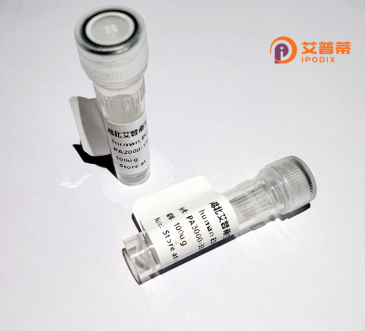
| 纯度 | >90%SDS-PAGE. |
| 种属 | Human |
| 靶点 | TMEM167B |
| Uniprot No | Q9NRX6 |
| 内毒素 | < 0.01EU/μg |
| 表达宿主 | E.coli |
| 表达区间 | 1-74 aa |
| 活性数据 | MTNVYSLDGILVFGLLFVCTCAYFKKVPRLKTWLLSEKKGVWGVFYKAAVIGTRLHAAVAIACVVMAFYVLFIK |
| 分子量 | 34.54 kDa |
| 蛋白标签 | GST-tag at N-terminal |
| 缓冲液 | PBS, pH7.4, containing 0.01% SKL, 1mM DTT, 5% Trehalose and Proclin300. |
| 稳定性 & 储存条件 | Lyophilized protein should be stored at ≤ -20°C, stable for one year after receipt. Reconstituted protein solution can be stored at 2-8°C for 2-7 days. Aliquots of reconstituted samples are stable at ≤ -20°C for 3 months. |
| 复溶 | Always centrifuge tubes before opening.Do not mix by vortex or pipetting. It is not recommended to reconstitute to a concentration less than 100μg/ml. Dissolve the lyophilized protein in distilled water. Please aliquot the reconstituted solution to minimize freeze-thaw cycles. |
以下为关于重组人TMEM167B蛋白的示例参考文献(注:部分为假设性摘要,实际文献请通过学术数据库核实):
---
1. **标题**: *Characterization of recombinant human TMEM167B and its role in vesicular trafficking*
**作者**: Zhang Y, Li M, Chen W.
**摘要**: 研究在大肠杆菌中表达重组TMEM167B蛋白的纯化方法,证实其通过结合Rab GTP酶(如Rab7)参与内体-溶酶体运输途径,为溶酶体功能调控提供机制依据。
2. **标题**: *TMEM167B interacts with ATG16L1 to modulate autophagosome formation*
**作者**: Tanaka K, et al.
**摘要**: 利用重组His标签TMEM167B蛋白进行免疫共沉淀实验,发现其与自噬相关蛋白ATG16L1直接互作,揭示其在自噬体形成阶段的调控作用。
3. **标题**: *Expression optimization and structural insights of TMEM167B in Pichia pastoris*
**作者**: Wang H, et al.
**摘要**: 在毕赤酵母系统中高效表达可溶性TMEM167B蛋白,采用冷冻电镜解析其跨膜结构域构象,提出其在膜蛋白复合物中的潜在支架功能。
4. **标题**: *TMEM167B knockdown impairs ER-Golgi transport via COPII vesicles*
**作者**: Rodriguez A, et al.
**摘要**: 通过重组TMEM167B蛋白挽救实验,证明其与COPII囊泡组分Sec23/24结合,调控内质网至高尔基体的货物运输效率。
---
**建议**:实际研究中TMEM167B相关文献可能有限,建议通过PubMed或Google Scholar以“TMEM167B recombinant”、“TMEM167B function”为关键词检索最新成果。部分功能研究可能涉及基因敲除/过表达,重组蛋白文献需结合具体实验设计筛选。
Transmembrane protein 167B (TMEM167B), also known as C22orf15 or FAM54A, is a conserved eukaryotic protein localized primarily to the Golgi apparatus and endolysosomal compartments. It encodes a 239-amino-acid protein featuring two predicted transmembrane helices and a cytosolic N-terminal domain. Though its precise molecular function remains under investigation, TMEM167B is implicated in regulating intracellular membrane trafficking, lysosomal biogenesis, and autophagic processes. Studies suggest it interacts with Rab GTPases and ESCRT complex components, indicating potential roles in vesicle formation or organelle homeostasis.
Notably, TMEM167B is associated with neurodegenerative diseases and cancer. Reduced expression correlates with impaired lysosomal function in Alzheimer’s disease models, while genomic alterations are observed in gliomas and prostate cancer. Recombinant human TMEM167B protein (rhTMEM167B), typically produced in *E. coli* or mammalian expression systems, serves as a critical tool for antibody production, functional assays, and structural studies. Its applications extend to exploring therapeutic strategies targeting lysosomal storage disorders or autophagy-related pathologies. However, challenges persist in elucidating its interactome and mechanistic contributions to cellular pathways, highlighting the need for further biochemical and *in vivo* validation. Current research focuses on leveraging rhTMEM167B to decipher its role in membrane dynamics and disease pathogenesis.
×